“We were building something we could only half imagine
A life miraculously self contained
Mirror image of its own best intentions
A weightless infrastructure
Floating on earth like foam on the sea+ dreaming of its own future irrelevance”
– Mill & Jones, “Exile’s Letter” in Gross Ideas, Tales of Tomorrow’s Architecture
THESIS
The Forth & Clyde Canal signalled and sluiced the mineral resource wealth that lay under the hills of Scotland’s central belt. The canal remains a register of the environmental legacy of an industrial extractive age: the Anthropocene of ferrous pollution in waterways from long-abandoned mines to poor soil and air quality, meteorological unpredictability. Three Actuarists’ houses were proposed: imagined as sampling stations dotted along the Canal’s territories, serving as architectural tools to measure, and collect samples and divinings of elemental factors.
Using Bruno Latour’s Gaïa Global Circus as a framework, our architectures notice and exaggerate discordances between the realities of global climate change and its public perception. Latour positions the artistic desire to narrate world events through performance, coinciding with the scientific interest in measured evaluation of environmental disasters. The Anthropocene Survey is sited on a land remnant between Canal and Clyde estuary at Old Kilpatrick encompassing both scientific and intuitive means. Empirical survey methods of the “-ologists” (scientists) overlap with the mirrored (musical) work of the “-mancers’” divination in a public Forum, an operatic synthesis of distinctive acoustics, the sequencing of spaces and scripted organisation that inform the Survey Institute as a “redefined assemblage of values”.
RENZO X LUIGI
Our interest in creating an architecture that contended with voices was in great part attributable to Luigi Nono’s 1984 contemporary operatic piece, Prometeo, Tragedia dell’Ascolto. The piece was initially performed in an auditorium designed by Renzo Piano, which was as unconventional as the opera itself. The ship-like structure enabled the movement of the musicians above and around the audience, inverting conventional arrangements of performance spaces. This complimented Nono’s intention that the ““tragedy of listening” should be understood as the ability to seize what happens in a unique, unrepeatable moment, which exhorts us each time to overcome our limited knowledge without taking anything for granted”, something that perfectly describes the endeavours of both our “-ologists” and “-mancers”; establishing the commonality of their goal.
The Prometeo auditorium was designed to be a temporary installation within San Lorenzo in Venice, a 9th Century church. The material qualities of the timber and scaffold structure are material motifs which emerge throughout our project, their design amplifying the sounds within. But it is the acoustic relationship of the spaces ‘without’ – such as between the masonic walls of the church and the curved timber panels of the auditorium – which peaked our interest and led us to design approaches for the public parts of our project.
THE MITHRAEUM
The London Mithraeum represents a real-world example of the carving of a stratum to reveal a hidden world. A Roman temple dedicated to the cult of Mithras which holds at its heart the mythological scene of Mithras killing a bull in a cave, the Mithraeum offers a physical embodiment of the power mythology wields in its ability to captivate and influence.
The site is a shrine to ancient Roman mythological belief systems housed within the Bloomberg building, one of the world’s most powerful modern capitalist institutions – it is the physical juxtaposition between myth and reality which seeded our own investigations into myth surrounding the elemental components of the Forth & Clyde canal. The industrial heritage of the canal region tied into its close alignment with the Roman Antonine wall presented an ideal testbed.

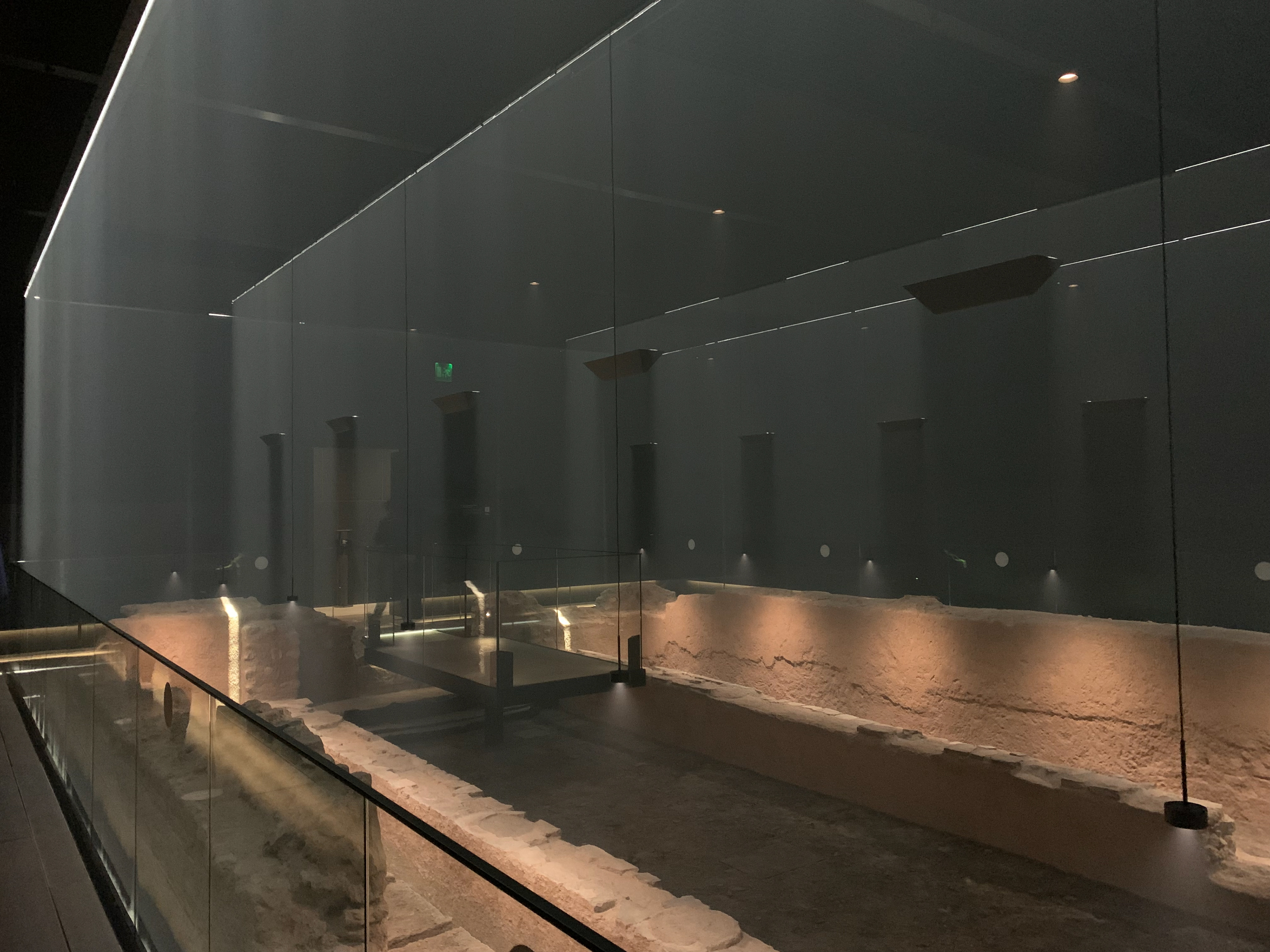
GAÏA GLOBAL CIRCUS
“Just as a geologist can hear the clicks of radioactivity, but only if he is equipped with a Geiger counter, we can register the presence of morality in the world provided that we concentrate on that particular emission. And just as no one, once the instrument has been calibrated, would think of asking the geologist if radioactivity is “all in his head,” “in his heart,” or “in the rocks,” no one will doubt any longer that the world emits morality toward anyone who possesses an instrument sensitive enough to register it.”
– Bruno Latour, An Inquiry into Modes of Existence
Through studies of the Forth & Clyde Canal and its industrial history, as well as in-depth investigations into the environmental conditions around Croy, the state of the central belts climate and environment emerged as a key issue. By extension, concerns were raised regarding the impact of heavy industries on the global climate – the Anthropocene. Despite contending with very different scales, these are intrinsically and inextricably linked.
Countless studies offer a wealth of evidence proving the negative impact human activity is having on the environment and climate, yet society continues to respond to climate change with tepid engagement, as if it is a mythic apocalypse that the future will fix. When viewed through the lens of Prometeo, which sought to encourage the audience to expand their knowledge - challenging preconceived notions which they might have held prior - the aims between the art and scientific community align despite the common understanding of them as entirely differing and separate strands of knowledge-forming.
As such, our “-mancer” characters began to take form, interpretive divination was a recognised art form - often given by Divinities - and an observational science. This was a union between science and art, a practice that was banned by the Church as Satanic and long since abandoned during The Enlightenment as unscientific.
The union of art and science as two complimentary strands of knowledge-forming led us to Bruno Latour’s Gaïa Global Circus. The circus consists of a theatre piece concerning the dichotomy between the apocalyptic reality of climate change and the public’s state of incredulity that it’s whistle-blowers are often met with.
This continues to snowball as a key societal and political issue for the future of our species, as the ‘culture-wars’ take hold and polarise our society further, often using the welfare of Gaïa as hostage. The ability for two differing parties to engage in productive, civil debate is imperative, and a duality which we have paid close attention to in the development of our project, both as a team between ourselves in entering ‘negotiation’ stages of initial massing design work, and as a driver of thesis to support the programme and characters which our architecture encompasses.
Two main topics of exploration emerged from engagement with Latour’s work: First, how might challenge, engagement and cooperation architecturally manifest? And Second, how can this “redefined assemblage of values” manifest architecturally in the public realm, fitting within Latour’s search for a “new eloquence with which to engage political ecology” and that might connect with the “energy of collective aesthetic experience” confronting the cognitive dissonance of the human relationship to Gaïa, climate change and to each other.
OPERATIC STRUCTURE
Tre Voci follows the operatic structure of Luigi Nono’s Prometeo. Primary acts throughout the opera are embodied within architectural forms to influence important milestones in the elements journey from sampling station to stasimo secondo.
Prologo
Opera begins with recital of Greek gods’ genealogy from Gaia to Prometheus
Prima Isola
Mythology intervenes, questioning Prometheus of his guilt
Seconda Isola
Prometheus is pushed towards an insatiable desire for “beauty and discovery”
Interludio Primo
Inaudible instrumental break hints “towards the subtle, the listening of rocks”
Tre Voci (a)
Three sound levels intertwine, seizing a timeless moment of coming together and uniting
Terza, Quarta, Quinta Isola
“The most shattered mythology of the work.” The “texts” of the three islands are interwoven
Tre Voci (b)
“Shreds of previous islands reappear”
Interludio Secondo
Seamless orchestral transition towards finale
Stasimo Secondo
Final lines suggest the “opening of many ways and many silences”
Prologue
Samples are collected and transited along the canal to the Anthropocene Survey.
First Isolation
Samples are also scrutinized, being tested for impurity.
Second Isolation
-mancers divine elemental samples, moving towards the creation of sound and interpretation.
First Interlude
Architectural interlude through journey and courtyard.
Three Voices (a)
Sounding chambers across the institute begin testing sounds divined from samples.
Third Island, Fourth, Fifth
Forum facilitates the combination of scientific findings for public interface with -ologists.
Three Voices (b)
Sound testing continues and intensifies as additional samples are added.
Second Isolation
Final sounding performance is prepared for sounding into stasimo.
The place where the chorus dances
Performance of the elemental state of the canal region is sounded out from the facades of the institute. The Stasimo Secondo facilitates the interface between the -mancer and the public.
OPERA OF CROY
As you journey the waters of the Forth & Clyde, it is hard to imagine its past as the backbone of heavy industry in 18th Century Scotland. On the way to Glasgow, there is one site which is highly charged with ancient and industrial monuments of memory: Croy. This group model served to understand and contextualise the Anthropocenic effects of human activity in the central belt through a series of “tracings” shown by each strata from which we discerned the elemental conditions that our “-ologists”, “-mancers” and architecture would contend with.
Water emerged as a key elemental theme because of the prevalence of the canal as a site of movement and transience. Its position between two of Scotland's major rivers, the Forth and the Clyde, allowed it to act as a conduit between hubs of industry. Crucially because it is the source of interest to study the effects of human extractive activity across the central belt. The great legacy of the mining industry can be found in the waters that run and seep from its now disused mines. The affluent from these mines carry within them high levels of pollution, such as ferrous sediments which flow into bodies of fresh water in the central belt territory, affecting both plant and animal life. As such, water quality becomes the subject of study in the Hydrological Survey within the institute as an important issue to contend with, especially as the scarcity of sources of fresh water quickly rise in global attention as rainfall decreases, and sources continue to be polluted by extractive industries.
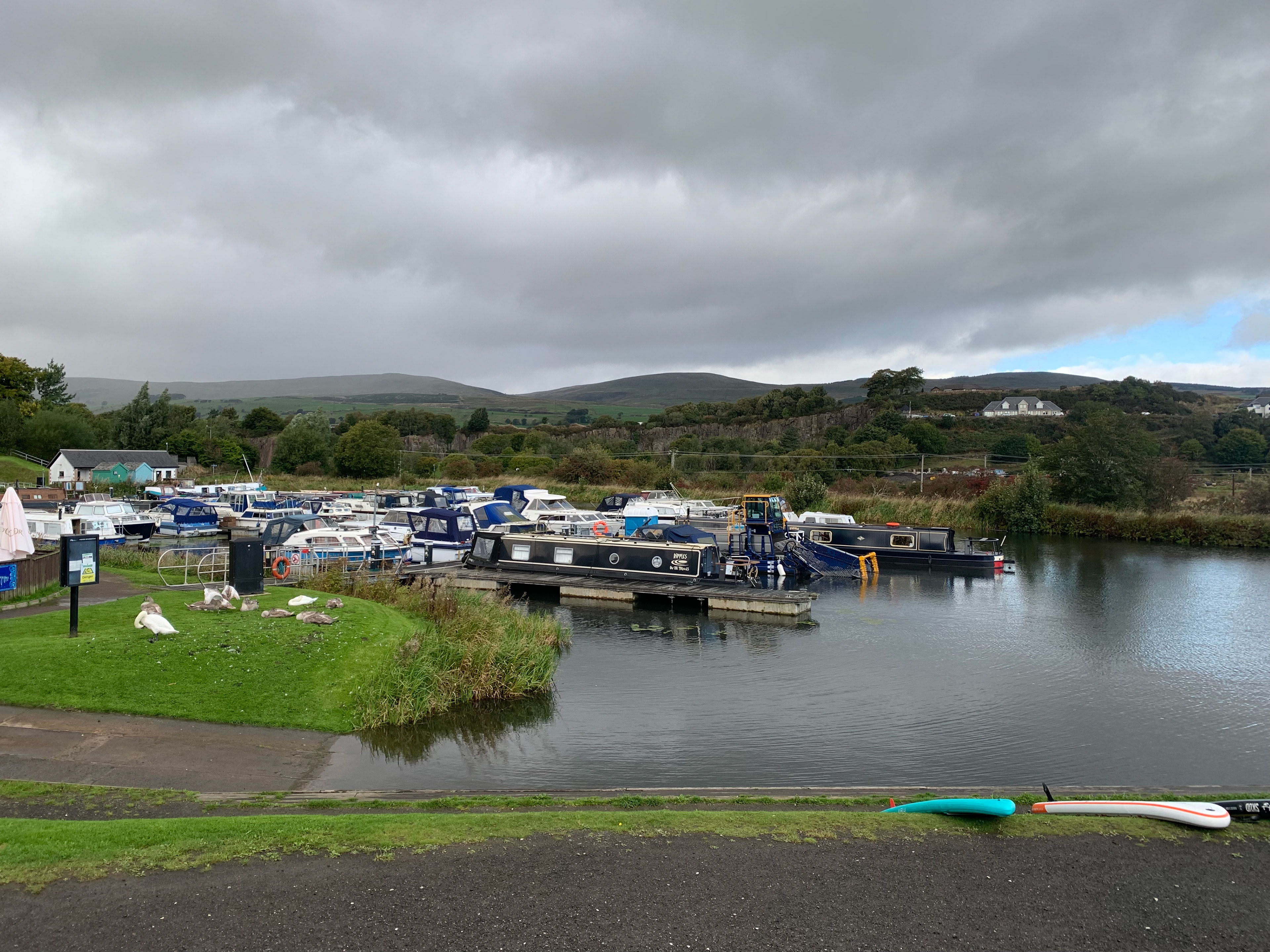
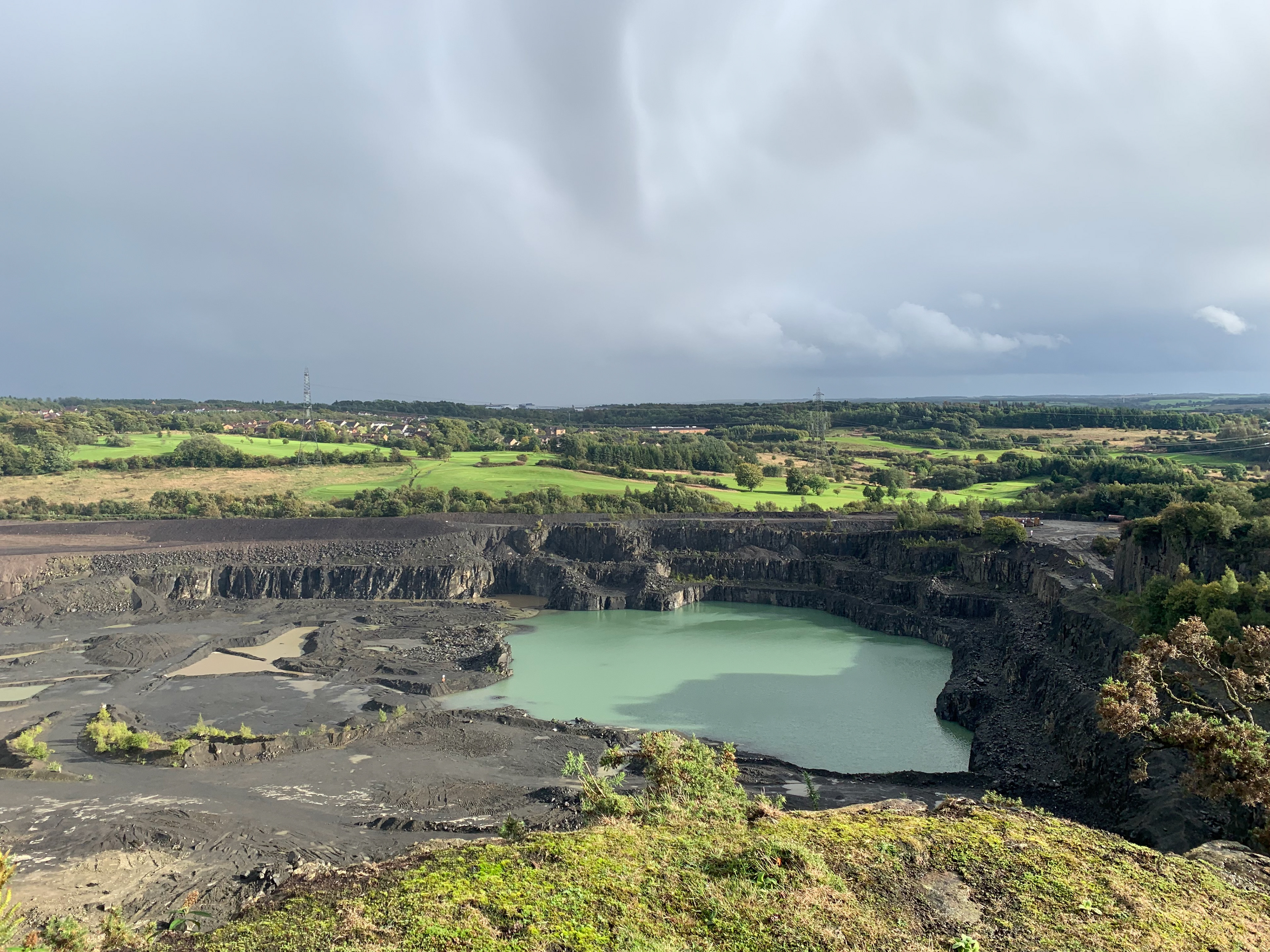

OUTPOSTS CROY
Three actuarist houses, or sampling stations, make up each outpost along the length of the canal. Croy Station provides the testbed for initial investigations as the area offers a broad range of elemental conditions relevant to the mission of the sampling stations, with a rich history of heavy industries on the site, including coal mining and stone quarrying. Activity on the canal is also particularly concentrated here and its proximity to industrial regions and transportation networks make it a suitable candidate for station testing.
Croy Station is arranged to best accommodate all positions in collecting their samples in the most efficient manner possible. Wind samples are collected 130m above sea level on the leading Southwestern edge of Croy Hill, in the path of the prevailing wind. Soil samples are taken from within and around the surrounding disused quarries and mines while water samples are extracted from the canal itself.
Croy is one of thirteen stations sited along the length of the canal in similar configurations – ensuring an even and regular flow of samples to the institute.
HYDROLOGIST SAMPLING STATION
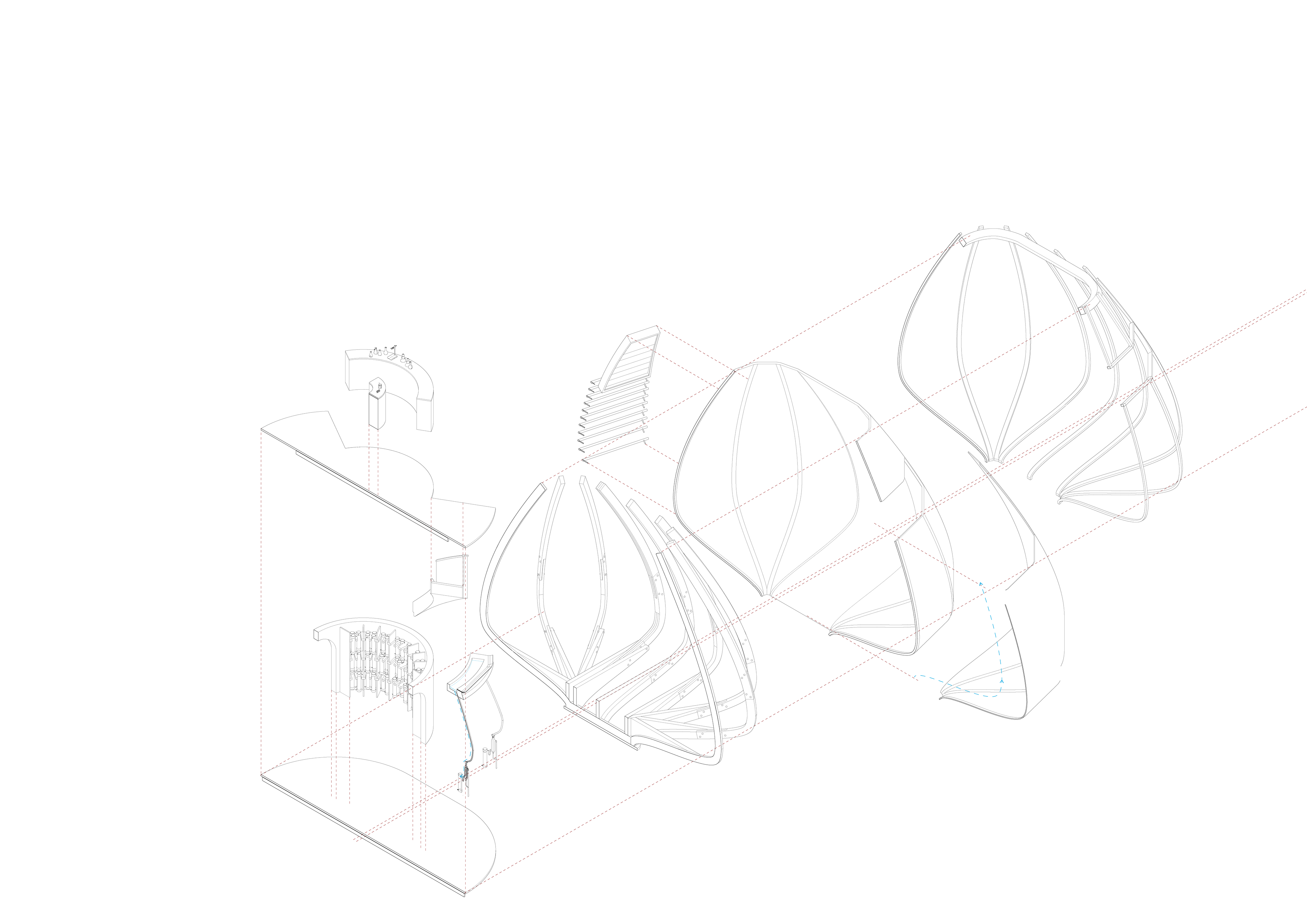
Divination through the analysis of water, whether in a bowl or free-flowing river, arises in many cultures throughout the world. Once considered both an art and a science, and since banned by Christianity, assessment of real-world conditions and predictions continues to be a science (albeit a more reliable one): Hydrology. Hydrologists take samples of water and analyse the chemical compounds present in the sample, as well as conducting readings of speed, swell and fall-off in a variety of environments. This house – a vessel to travel to necessary outposts – takes advantage of the elemental nature of water, and its ability to be moved by capillary action and enables a symbiotic relationship between the Hydrologist as analyser and the architecture as water collector.
THE GAÏA ANTHROPOCENE SURVEY
The scope of the Anthropocene survey covers the extents of the Forth & Clyde Canal and takes into consideration parallels between the Latourian aims of our project and Renzo Piano’s architectural response to Prometeo. Piano’s performance space accommodated 80 musicians - following this precedent, the Anthropocene survey is home to 80 “actuarists.” 40 ‘-ologists’ and 40 ‘-mancers’.
39 sample stations positioned along the length of the canal supply a regular flow of material to the institute, divided into 13 stations dedicated to each elemental survey.
Siting the Survey in Old Kilpatrick is the natural conclusion to our journey along the canal network, from the terminus of the Union canal in Edinburgh, through Croy and terminating where the Forth & Clyde canal finally joins the river Clyde.
The Old Kilpatrick site is a prominent slice of land suspended between the canal and the banks of the Clyde. It is here where the point of intersection between the Forth & Clyde canal and the Antonine wall is found, as well as being an area of considerable post-industrial heritage - serving as a terminal of the Erskine ferry prior to construction of the Erskine bridge and part of the route of the Dumbarton and Lanarkshire railway line before its decommission.
The site is a highly charged intersection of industry, memory, myth, and the elements.
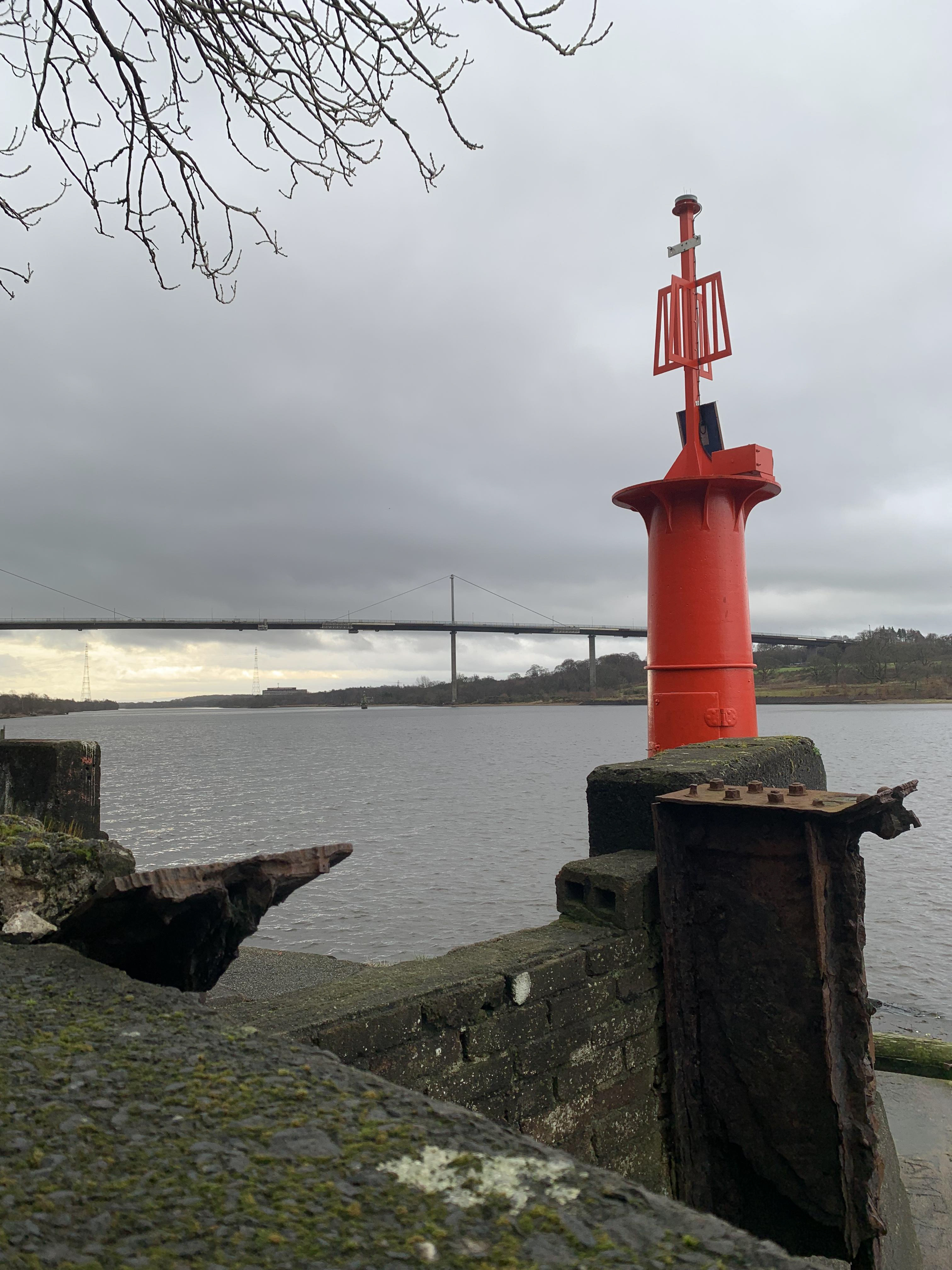
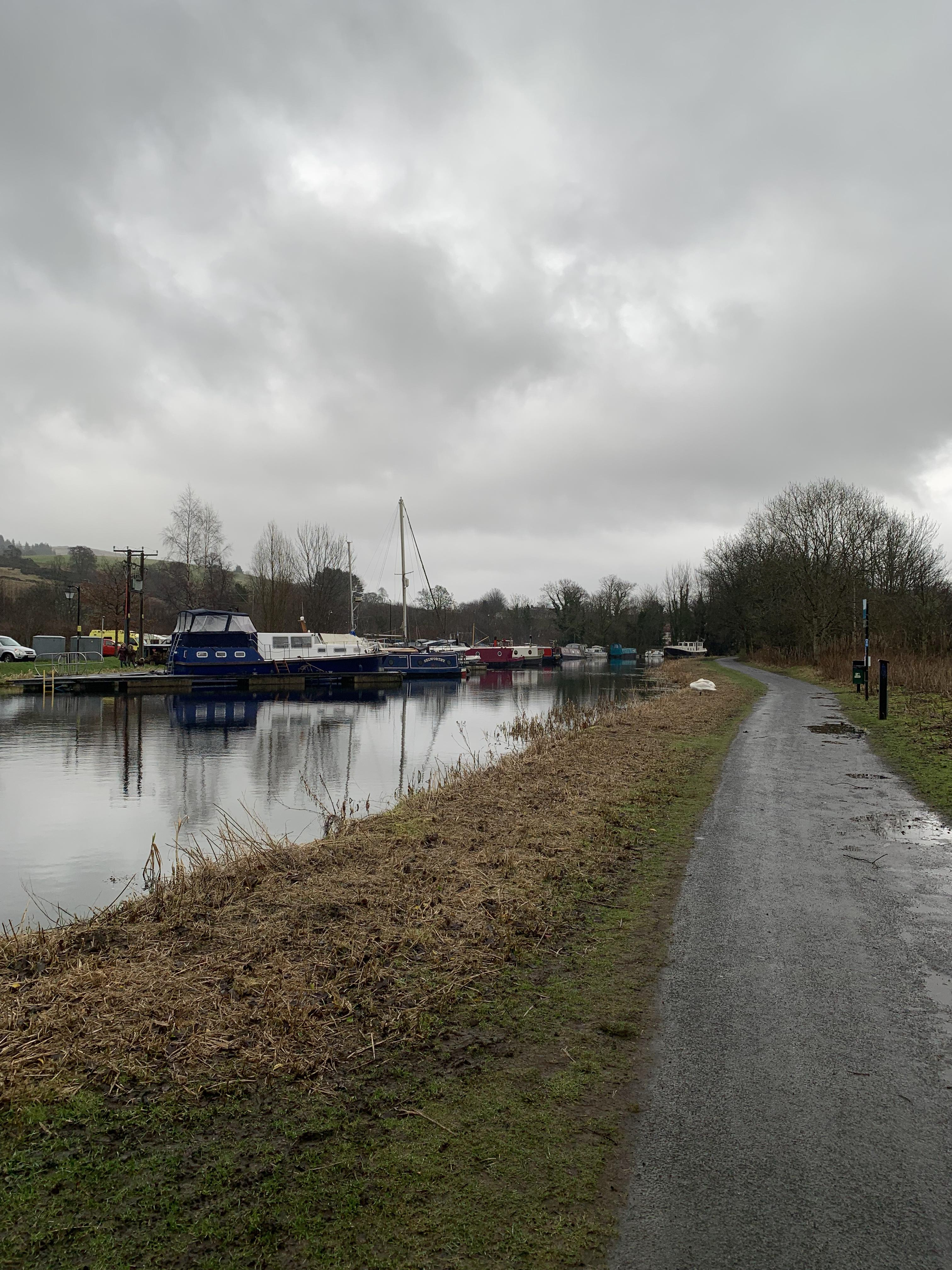
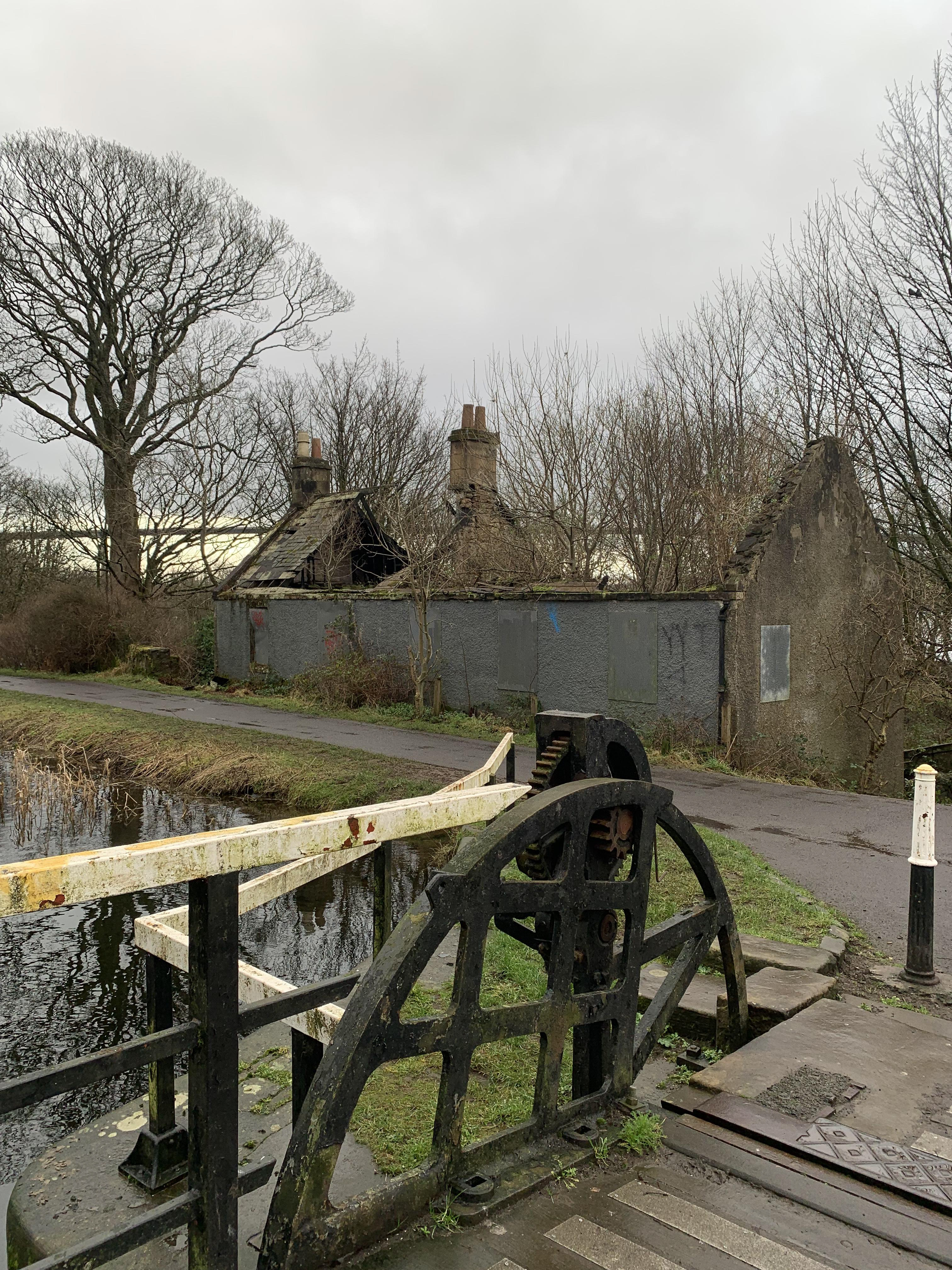
CARVING, SCRAPING
Research into divination provided us with a better understanding of pre-scientific methods of observation and interpretation, in conjunction with the ways in which such information would be recorded. The most reliable method of the time was to etch information into clay tablets, a laborious process but one with a very deliberate permanence. A physical symbol of the importance of the subject.
In this spirit, we chose to process our own information into plaster casts, carving in relevant tracings before scraping back a light layer to prepare the surface for additional input. The scraping removed lightly etched, less important pieces while embedding deeper, more permanent cuts into the body of the tablet.
In this iterative process, we achieved a density of understanding that fed directly into the moves that we made on the Old Kilpatrick site. Many of the markings and scrapings made on the site model influenced the massing movements for our Anthropocene Survey, including the way we brought the canal into the midst of our buildings, and how we thought about the experiential and programmatic experience of the public movement to and across The Anthropocene Survey.
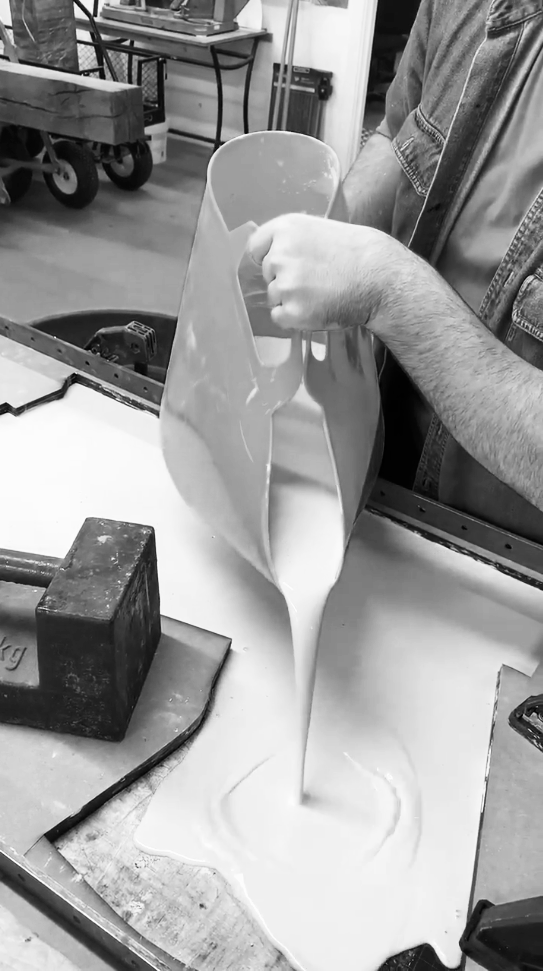
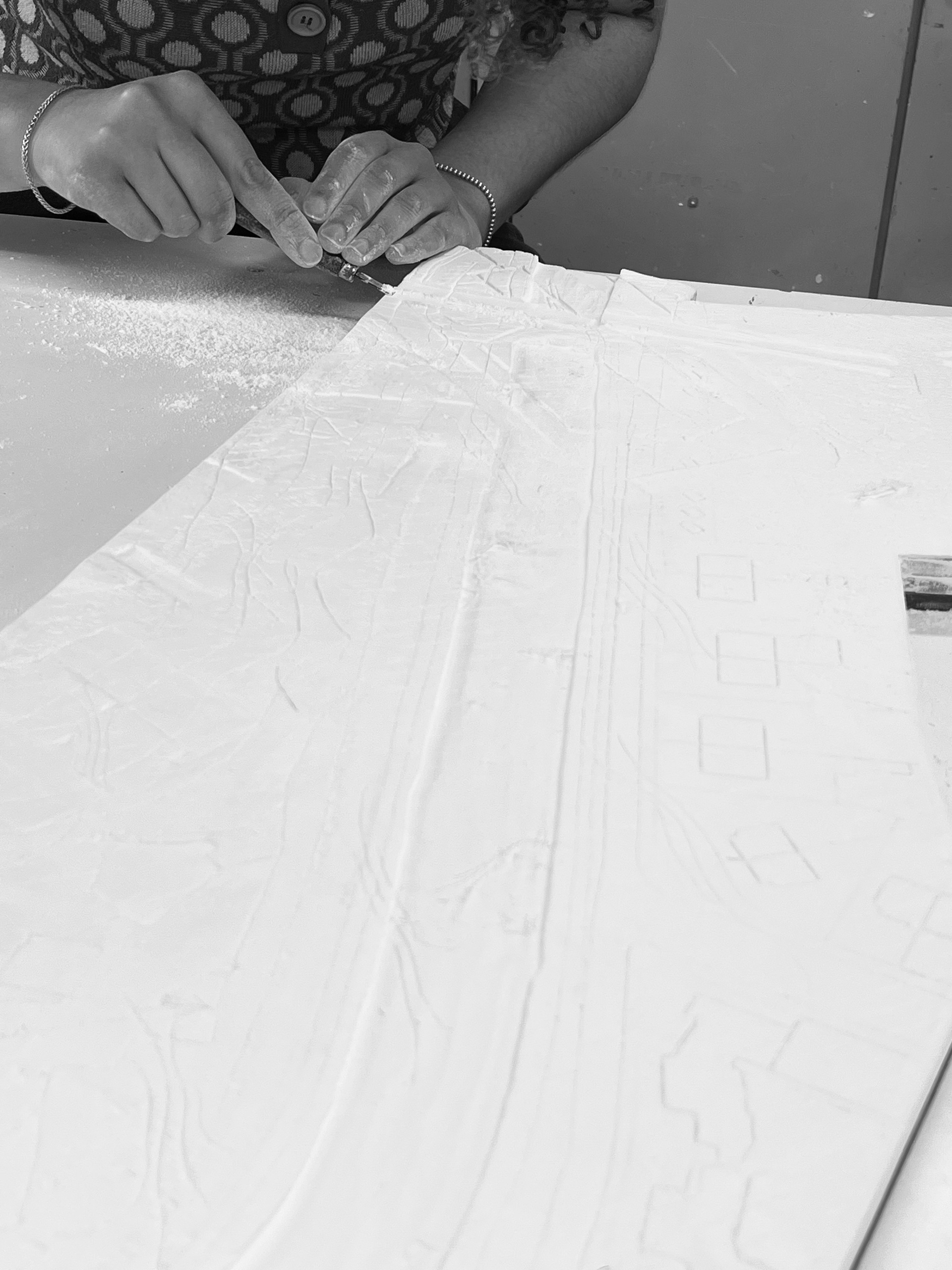


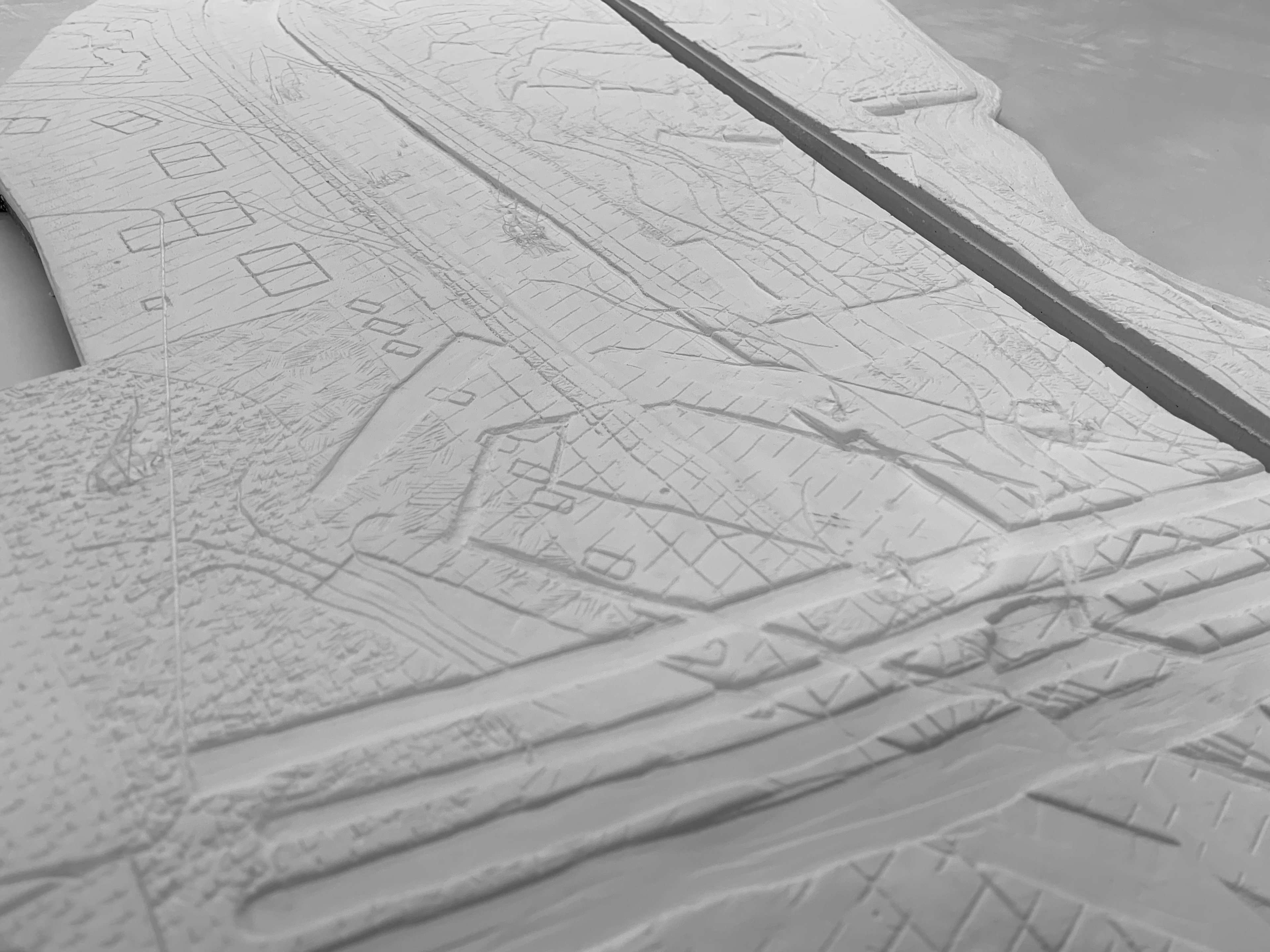
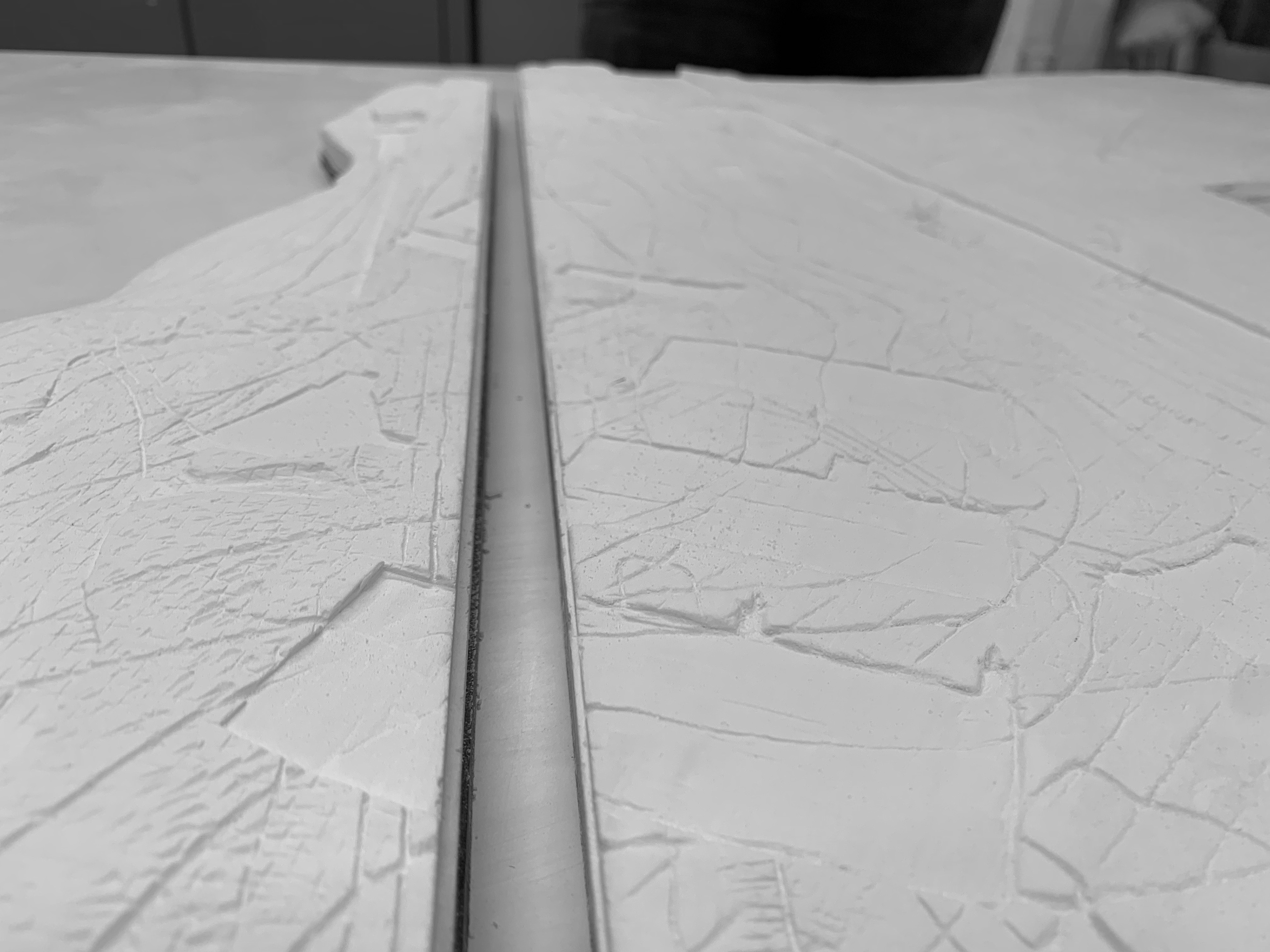
ISOLA TERZA: FORUM EXCHANGE OF IDEAS
As we progressed through the project and the spatial relationships between our “-ologists” and our “-mancers” became more established, we turned our attention to consider how each of them would interact or present their findings to the public, and what architecture would enable the public itself to engage with the environmental purpose of the Survey.
Here the presence of the Roman Antonine wall became a key influencer of our choice to create a Forum whereby ideas can be exhibited, exchanged, discussed. Much like in Ancient Roman times, the space we designed serves as a public arena, an external but covered space where people could simply gather. This is part of the operatic climax of the journey through the Institute, whereby the visitor can follow the new waterway from site entrance beside the Antonine distance stone all the way to a central reflecting pool in the centre of the domed Forum. The amphitheatre steps down to the pool, accessing a relaxed area for individuals or groups to occupy.
Many of the architectural moves are nods to these historic Roman architectural details; the oculus at the top of the dome gives a sense of time as the sunlight crosses the inside of the smooth dome and skims the central pool. Between the colonnades that surround the amphitheatre, views out across the Clyde to the Erskine Bridge, the saltmarshes and the Stasimo Secondo, an open public square, sunken between the buildings of The Anthropocene survey.
The outside skin of the Forum encompasses ramps down to the Stasimo, and up to the top of the dome. The latter is sheltered from the elements, and allows for public displays of the “-ologists” findings to be exhibited and experienced on the way to the top. There a visitor is frustrated in their views – narrow, vertical and horizontal slit openings restrict the view to local and far-away landmarks, cities, and towns which have influenced the siting, designing and functioning of the Survey; much in the way that Latour sews a rich tapestry of voices in the Gaïa Global Circus whereby they “trace, watch, project, worry, make astonishing discoveries, and knit together the voice of Gaïa”, this voice is represented in the Forum of The Anthropocene Survey, and so becomes the site of “-ologist” and public interface.
ISOLA TERZA: EXHIBITION
A major element of the Forum is its use as an interface between the public and the “-ologists”, it functions as a space where the scientific, environmental findings can be both discussed and displayed in a more interactive manner than traditionally possible. The space provided along the winding ramp up to the roof creates an intimate, atmospheric space which encourages scientific engagement, allowing exhibitions to be built that would appeal and communicate the “-ologists’” findings in an accessible manner.
This aspect of the Forum emerged as we designed and built our own 1:1 exhibition of the Anthropocene Survey and discussed ways and forms to build a temporary structure which would best communicate our work. Renzo Piano’s work for Prometeo once again weighed in on the design of this temporary display, as the relationship between the church walls and the lightweight construction of the auditorium resonated with the heavy, masonic construction of the Forum, and the need for the exhibition to be lightweight and temporary in its construction.

MIG Welded steel frame
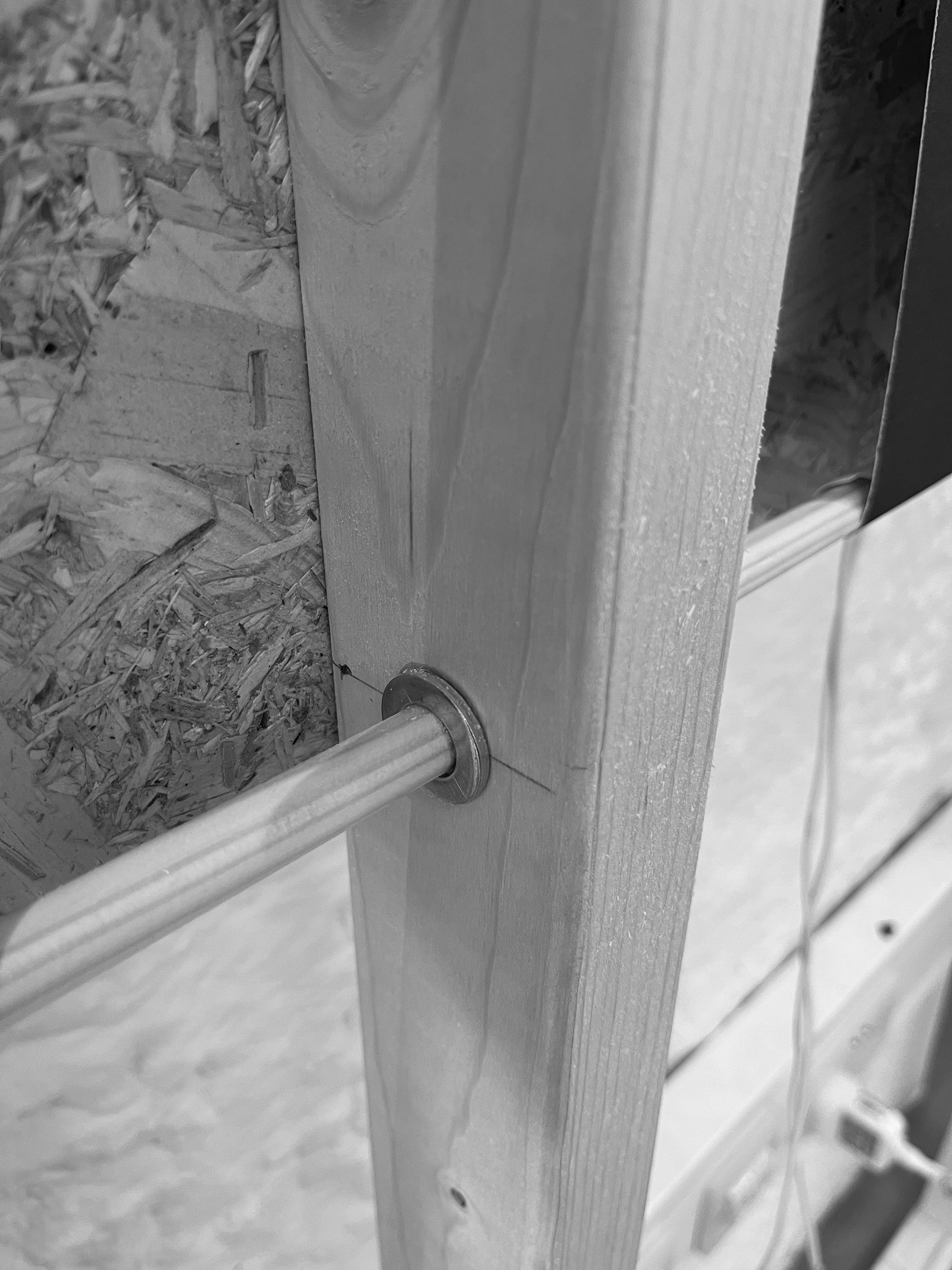
Dowel/stud connection detail

Final exhibition at ESALA
STASIMO SECONDO
The place where the chorus dances. The Stasimo Secondo utilises architectural intervention throughout the institute to facilitate the conveyance of elemental information through sound, its architecture serves as the instrument which allows mancers to interface with the public.
Inspired by the Renzo Piano designed stage for Luigi Nono’s Prometeo, The Stasimo Secondo is designed to place the listener in the centre of the performance, with sounds being produced from all directions surrounding them. Façades of the Geological, Hydrological and Meteorological surveys contain sounding chambers which face into the space and sound-out their findings to the public. It is the finale piece in the institute’s mission to find Gaia in the Forth & Clyde canal, culminating in a global circus-esque performance which brings the creative arts back into the conversation surrounding the climate emergency and important climatological events.
ARIA OF WATER
The Forth & Clyde canal is used to transport water samples from sampling stations to the Gaïa Anthropocene Survey for analysis. The sample vessels flow into the new canal which we have carved into the Old Killpatrick site to serve the institution, and aid in the delivery of these samples. The hydrologists’ aim is to examine the polluting legacy of the mining industry within bodies of water across the central belt of Scotland, and to endeavour to communicate their findings within the open Forum, creating an accessible public interface.
The acoustic design of the Stasimo façade amplify the hydrolophones. When “-mancers” play, the acoustics resonate within the Stasimo transforming it into a tangible space that behaves like an auditorium. Visitors, having encountered the scientific exhibition in the Forum, and the water treatment works, are met with the undeniable, urgent cacophony of the hydromancer’s song.
The hydrology survey itself is designed to make the most of the water that surrounds it – dual aspect to both the canal and the river Clyde, as well as having internal pools that reflect the hydrologists vertical movements across the building.
Renzo Piano’s auditorium was a key inspiration for the design of the hydrologist buildings and their relationship to the hydromancers’ spaces. As shown by the concept sketch, the early design concept included voids and courtyards that would amplify the hydromancer’s sounds, to be heard by the hydrologists.
Materially, the architectures were similarly split. Timber construction for the hydrologists; external and internal fins that resemble the ship-like ribs of the Prometeo auditorium, deep eaves and shutters for solar shading also serve as sounding boards to amplify and reflect sound. Equally, the hydromancer architecture with its masonic, monasterial qualities are a direct reference to the church (San Lorenzo, in Venice) that housed the Renzo’s auditorium and Nono’s opera.
Within the framework of Latour’s Global Gaïa Circus, the hydromancers serve to re-frame the scientific findings in a way that will engage the public to connect with the “energy of collective aesthetic experience”.
Historically, hydromancers were the sages of their community; they would interpret the movement, colour and reflections of water using a variety of tools at their disposal. The hydromancers of the Anthropocene Survey continue this tradition, by pouring the water samples into a divining bowl and interpreting its consistency, colour, and movement. Culturally, divining itself was often a performance, something that is present in the architecture of the divination rooms which are all public-facing towards the Stasimo Secondo and the Forum.
The new canal carved out of the site allows water to flow from the Forth & Clyde canal down and through the buildings of the Anthropocene Survey. The movement of the water is reflected by the movement of the public through the site, who are guided towards the Forum and down to the Stasimo Secondo.
The water management of the project also mirrors this movement, piping grey water to the primary water treatment works which are located directly underneath the Forum amphitheatre. In this way, when visitors travel down to the Stasimo, they are confronted with the consequences of water use. The clean water is then passed through into the wetlands, which serve as a natural, sustainable passive water treatment.
The acoustic design of the Stasimo façade amplifies the hydrolophones. When “-mancers” play, the acoustics resonate within the Stasimo transforming it into a tangible space that behaves like an auditorium. Visitors, having encountered the scientific exhibition in the Forum, and the water treatment works, are met with the undeniable, urgent cacophony of the hydromancer’s song.
“Gaia approaches.”
Latour, Bruno. An Inquiry Into Modes of Existence. United States: Harvard University Press, 2013, 13.

